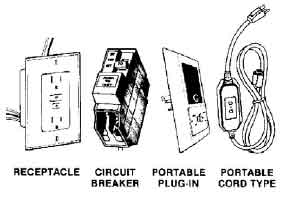Questions #6 – 10 are based on the passage and diagram below.
A ground fault occurs when an
unintentional path is created between a source of
current, such as a damaged electrical cord and
the ground. Human beings can provide that path.
The result can be a burn, shock or electrocution.
Ground-fault circuit
interrupters (GFCI) protect against
shock by measuring the current
going into an appliance and
coming out. Any discrepancy
between the two indicates that
electricity is passing where it
shouldn’t - for instance, from a
faulty electrical cord, extension
cord or appliance.
The GFCI constantly monitors
electricity flow in a circuit. When the GFCI
detects leaking current, it switches off power
before serious injury or damage can occur. A
difference of only 5 milliamperes (5 thousandths
of an ampere) is enough to trigger a GFCI.
There are three types of GFCI’s: The
receptacle GFCI is used in place of the standard
duplex receptacle. It fits into the standard outlet
box. Most GFCI’s can be installed so that they
also protect other electrical outlets further
downstream in the branch circuit.
The circuit breaker GFCI is used in
buildings that have circuit breakers rather than
fuses. The GFCI is installed in a panel box to
give protection to selected circuits. This type
serves a dual purpose: it shuts off electricity in
the event of a ground-fault, as well as when a
short-circuit or overload occurs. The groundfault
protection covers both the wiring and each
individual outlet, lighting fixture or appliance
served by the branch circuit protected by the
GFCI.
Portable GFCI’s are used when
working outdoors, or in other situations when a
permanent GFCI is not practical. These can take
two forms: either a single outlet adapter or an
extension cord and GFCI combined.
GFCI protection is required, by code,
for most outdoor receptacles, bathroom
receptacle circuits, garage wall outlets, kitchen
receptacles, and all receptacles in crawl spaces
and unfinished basements.
The Regulations for Construction
Projects (Ontario Regulation 213/91) make
ground-fault circuit interrupters (GFCI’s) mandatory whenever portable electrical tools are
in use outdoors or in wet locations. In this case,
the GFCI shall be installed at the receptacle or on
the circuit panel. (Section 192)
Furthermore, when a ground-fault is detected it
is the worker’s responsibility to locate and repair
the cause. According to the regulations, “A
ground fault that may pose a hazard shall be
investigated and removed without delay.”
(Section 193)


- If the GFCI is tripped, this usually indicates
- a discrepancy of 3 miliamperes;
- a discrepancy of less than 5
miliamperes
- a discrepancy of 5 miliamperes or more
- a discrepancy of 25 miliamperes or
more
- A GFCI that is installed at the circuit
breaker panel
- Can only be used outside and in wet
areas
- protect all the appliances, light fixtures
and receptacles on the protected branch
circuit
- protect only bathroom areas
- are regulated for use only with electric
power tools
- What is the best title for this passage?
- a) Preventing Electric Shock
- b) Electrical Safety Codes
- c) The Flow of Electricity
- d) Ground-Fault Circuit Interrupters

